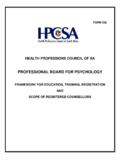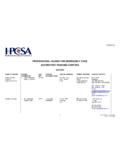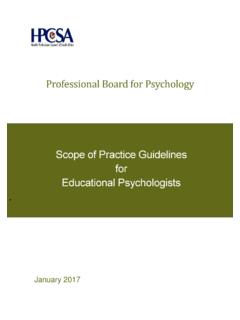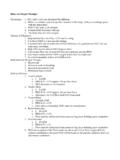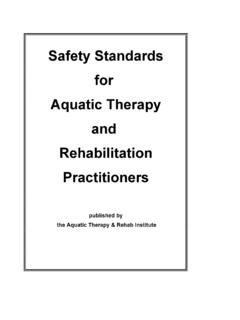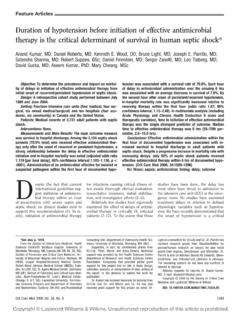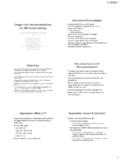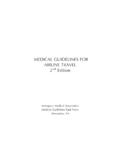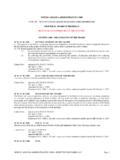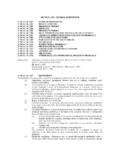Transcription of HEALTH PROFESSIONS COUNCIL OF SOUTH …
1 FORM 314 HEALTH PROFESSIONS COUNCIL OF SOUTH africa professional BOARD FOR EMERGENCY CARE EMERGENCY CARE TECHNICIAN SCOPE OF PRACTICE 2009 ECT Scope professional Board for Emergency Care - 2009 2 TABLE OF CONTENTS 1. Introduction Pg 3 2. Capabilities Pg 5 3. Protocols: Anaphylaxis Pg 8 Bronchial asthma Pg 13 Cardiac arrest adult & child Pg 15 Resuscitation of a newly born / neonate Pg 17 Seizures Pg 18 Acute coronary syndrome Pg 20 Acute pulmonary oedema Pg 21 Symptomatic bradycardia Pg 22 Pathological tachycardia Pg 23 Symptomatic hypoglycaemia (HGT< ) Pg 24 Analgesia Pg 25 Poisoning / overdose Pg 26 Declaration of death Pg 28 ECT Scope professional Board for Emergency Care - 2009 3 INTRODUCTION These ECT protocols have been carefully designed through a process of consultation with emergency care and medical specialists including input from Higher Education Institutions, Colleges, the National Department of HEALTH and the professional Board for Emergency Care.
2 These protocols are aligned to the 2008 American Heart Association Guidelines. As research is conducted and new evidence becomes available the protocols may be amended by removing, including and / or adjusting the procedures and medications. At all times members of the emergency care profession should remain aware of the important fact that ones professional status and standing within a profession should not be purely defined by a scope of practice but rather by ones level of education and training. The patient s right to appropriate evidence based pre-hospital medical intervention thus becomes central to any decisions made relating to scope of practice and / or protocol. Emergency Care Technicians (ECT) are set to play a vital role in the provision of pre-hospital emergency care within SOUTH africa .
3 These protocols serve to guide actions in dealing with commonly encountered medical and trauma related emergencies. During the course of their duties the ECT will no doubt encounter a wide variety of patients and clinical conditions. For this reason it is neither possible nor feasible to design a protocol for every possible scenario. Providing pre-hospital emergency care requires a team approach, as such the ECT is encouraged to request the assistance and / or advice of a registered emergency care practitioner (ECP) or a medical officer (MO) should they feel it necessary to deviate from these protocols. As a registered ECT there are certain medications and procedures that you will be able to routinely and independently administer and perform as indicated in the following protocols.
4 Additional medications or procedures which are infrequently performed or which are invasive and / or potentially harmful to the patient require you to consult with an ECP or MO before going ahead with the relevant procedure. This consultation between ECTs and ECPs or MOs forms an important and necessary step in addressing issues of clinical governance, peer review and general professional development within the Emergency Care Profession as a whole. As a registered professional you should ECT Scope professional Board for Emergency Care - 2009 4 have a clear understanding of your own limitations, consult widely and regularly on all issues relating to the management of patients. In line with this there a certain clinical conditions and / or patients who will require medical treatment by a higher qualified person such as an emergency care practitioner or medical officer.
5 In such instances you are required to, without delay, request assistance from such individuals or should they be unavailable, transport immediately to the nearest appropriate medical facility. Explanatory notes These ECT protocols are to be read and interpreted taking the following into account: The protocols provide a skeletal framework guiding treatment; the focus is primarily on the administration of medications. It is therefore assumed that you have correctly performed the necessary patient assessments and have in fact properly identified the problem and or where applicable have arrived at an appropriate and correct diagnosis. Unless otherwise stated all references to medications that are administered via the intravenous route may also be administered via the intraosseous route.
6 Where a number of potential routes for administration and or ways of presenting and preparing medications exists, the most pragmatic method for use in the pre-hospital setting has been suggested. Information relating to the individual medications such as the class, scheduling, pharmacological action, adverse effects, indications and contra-indications are not included in these protocols. The onus is on the registered practitioner to ensure that they have an extensive detailed knowledge and understanding of each and every medication which they are entitled to administer. As Emergency Care Technicians are not authorized prescribers, you will be required to obtain these medications from an Emergency Care Practitioner or Medical Officer.
7 ECT Scope professional Board for Emergency Care - 2009 5 CAPABILITIES Sections that are greyed out require consultation with an Emergency Care Practitioner (ECP) or medical officer (MO) prior to performance of the associated procedure. However in the unlikely event that such consultation is impossible then you may proceed using sound clinical judgement and in accordance with these guidelines thereafter obtaining retrospective consultation. Airway Management 1. Finger sweep 2. Head-tilt-chin lift 3. Jaw-thrust 4. Cricoid pressure 5. Suction oropharynx 6. Airway obstruction / choking (basic life support level) 7. Oropharyngeal airway insertion 8. Nasopharyngeal airway insertion 9. Supraglottic airway devices ( LMA / DLA) in pulseless patients 10.
8 Supraglottic airway devices ( LMA / DLA) in patients without gag reflex and pulse present 11. Needle cricothyroidotomy 12. Nasogastric / Orogastric tube insertion in a conscious patient Oxygenation & Ventilation 13. Oxygen therapy 14. Nebulization 15. Use of pulse oximetry 16. Needle thoracentesis 17. Bag-valve-mask ventilation Circulatory Management 18. Peripheral intravenous cannulation > 1 years old 19. External jugular vein cannulation 20. Intraosseous cannulation 21. Umbilical vein cannulation 22. Fluid administration crystalloids & colloids 23. Intravenous & intraosseous drug administration 24. Intramuscular drug administration 25. Use of non-invasive blood pressure monitors 26. Use of tourniquet ECT Scope professional Board for Emergency Care - 2009 6 27.
9 Use of pneumatic anti-shock garment 28. Automated & Manual Electrical Defibrillation 29. Basic 3-lead ECG monitoring and rhythm identification (normal sinus rhythm, sinus bradycardia, sinus tachycardia, ventricular tachycardia, ventricular fibrillation, pulseless electrical activity and asystole) Obstetric Management 30. Normal vaginal delivery 31. Breech delivery 32. Prolapsed cord management (excludes tocolysis) 33. Fundal massage General 34. CPR (adult, child, infant & neonate) 35. On-scene discharge 36. Cervical spine clearance 37. Application of a cervical collar 38. Application of head blocks 39. Application of spider harness 40. Application of extrication devices 41. Application of splints including the traction splint 42. Application of vacuum mattress 43.
10 Use of stretchers 44. Urinary catheterization 45. General patient transfers excluding intensive care transfers & neonatal transfers 46. Basic wound care 47. Declaration of death where no treatment was initiated as the patient was obviously dead on arrival (decapitation, mortal disfigurement, rigor mortis, putrefaction, post mortem lividity) 48. Declaration of death where treatment has been initiated Medications (refer to individual protocols relating to required consultation) 1. Acetyl salicylic acid 2. Adrenaline 3. Amiodarone hydrochloride 4. Atropine sulphate 5. eta 2 adrenergic stimulants 6. Corticosteroids 7. Dextrose 50% 8. Diazepam 9. Flumazenil 10. Glucagon 11. Glyceryl trinitrate 12. Ipratropium Bromide 13. Magnesium sulphate 14.



